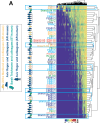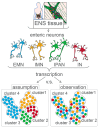This is a preprint.
A call for a unified and multimodal definition of cellular identity in the enteric nervous system
- PMID: 38293133
- PMCID: PMC10827084
- DOI: 10.1101/2024.01.15.575794
A call for a unified and multimodal definition of cellular identity in the enteric nervous system
Update in
-
A call for a unified and multimodal definition of cellular identity in the enteric nervous system.EMBO J. 2025 Sep 15. doi: 10.1038/s44318-025-00559-1. Online ahead of print. EMBO J. 2025. PMID: 40954253 No abstract available.
Abstract
The enteric nervous system (ENS) is a tantalizing frontier in neuroscience. With the recent emergence of single cell transcriptomic technologies, this rare and poorly understood tissue has begun to be better characterized in recent years. A precise functional mapping of enteric neuron diversity is critical for understanding ENS biology and enteric neuropathies. Nonetheless, this pursuit has faced considerable technical challenges. By leveraging different methods to compare available primary mouse and human ENS datasets, we underscore the urgent need for careful identity annotation, achieved through the harmonization and advancements of wet lab and computational techniques. We took different approaches including differential gene expression, module scoring, co-expression and correlation analysis, unbiased biological function hierarchical clustering, data integration and label transfer to compare and contrast functional annotations of several independently reported ENS datasets. These analyses highlight substantial discrepancies stemming from an overreliance on transcriptomics data without adequate validation in tissues. To achieve a comprehensive understanding of enteric neuron identity and their functional context, it is imperative to expand tissue sources and incorporate innovative technologies such as multiplexed imaging, electrophysiology, spatial transcriptomics, as well as comprehensive profiling of epigenome, proteome, and metabolome. Harnessing human pluripotent stem cell (hPSC) models provides unique opportunities for delineating lineage trees of the human ENS, and offers unparalleled advantages, including their scalability and compatibility with genetic manipulation and unbiased screens. We encourage a paradigm shift in our comprehension of cellular complexity and function in the ENS by calling for large-scale collaborative efforts and research investments.
Conflict of interest statement
Declaration of interests F.F. is an inventor of several patent applications owned by UCSF and MSKCC and Weill Cornell Medicine related to hPSC-differentiation technologies including technologies for derivation of enteric neurons and their application for drug discovery.
Figures









References
-
- Drokhlyansky E., Smillie C.S., Van Wittenberghe N., Ericsson M., Griffin G.K., Eraslan G., Dionne D., Cuoco M.S., Goder-Reiser M.N., Sharova T., et al. (2020). The Human and Mouse Enteric Nervous System at Single-Cell Resolution. Cell 182, 1606–1622.e23. 10.1016/j.cell.2020.08.003. - DOI - PMC - PubMed
-
- Wright C.M., Schneider S., Smith-Edwards K.M., Mafra F., Leembruggen A.J.L., Gonzalez M.V., Kothakapa D.R., Anderson J.B., Maguire B.A., Gao T., et al. (2021). scRNA-Seq Reveals New Enteric Nervous System Roles for GDNF, NRTN, and TBX3. Cell. Mol. Gastroenterol. Hepatol. 11, 1548–1592.e1. 10.1016/j.jcmgh.2020.12.014. - DOI - PMC - PubMed
Publication types
Grants and funding
LinkOut - more resources
Full Text Sources
Miscellaneous
